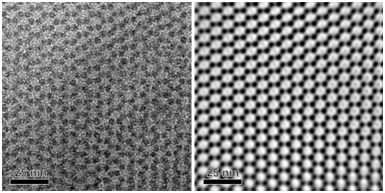Prof. Wei Wang’s group reported self-assembled artificial graphene in J. Am. Chem. Soc.
Two dimensional (2D) materials led by graphene and transition-metal dichalcogenides exhibit unique physical properties dominated by their 2D honeycomb structures. They have attracted intense interest because of their significance for both basic science and potential applications. Inspired by the success of these systems, designing new artificial honeycomb lattices is a rapidly expanding area of research aimed at developing novel 2D materials with properties beyond those of existing systems. The challenge is how to construct such structures, particularly on length scales beyond the covalent bonds.

Prof. Wang’ group reported a 2D honeycomb superlattice via self-assembly of a planar building block with well-controlled shape, containing two types of covalently linked organo-functionalized inorganic clusters. Electron microscopy has revealed single- and multilayer self-assembled sheets with a diversity of graphene-like stacking modes, albeit on an order-of-magnitude larger length scale.

This work had successfully constructed, through self-assembly, a mesoscale version of graphene-like nano-honeycomb monolayers. Like graphene, they were found to form bi- and tri-layers via different stacking modes. The successful generation of a self-assembled mesoscale graphene-like structure promises further developments of novel 2D materials with unique properties. The huge specific area combined with porosity of such structures can ensure highly accessible active sites and generate extremely high chemical affinity. The structure presented here can be regarded as a truly 2D cluster-based metal−organic framework, an emerging class of cluster-assembled materials with considerable potential for applications such as in catalysis, sensors, electrochemistry, membranes, 2D heterojunctions, and templated synthesis and as complex nanoreactors.
This work was supported by the National Natural Science Foundation of China and Ministry of Science and Technology of China and published in the international well-known chemistry journal-Journal of the American Chemical Society as a cover paper.


